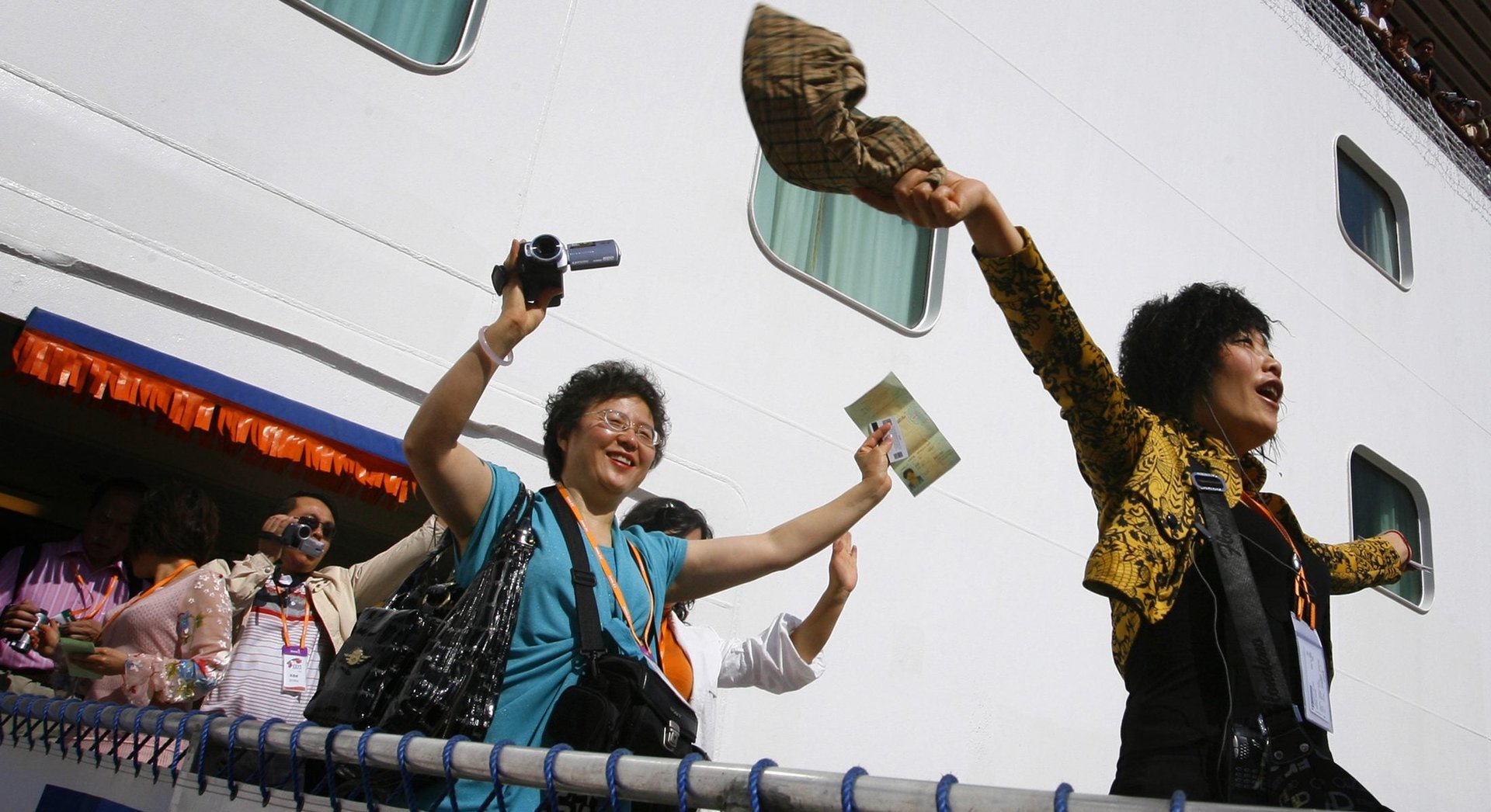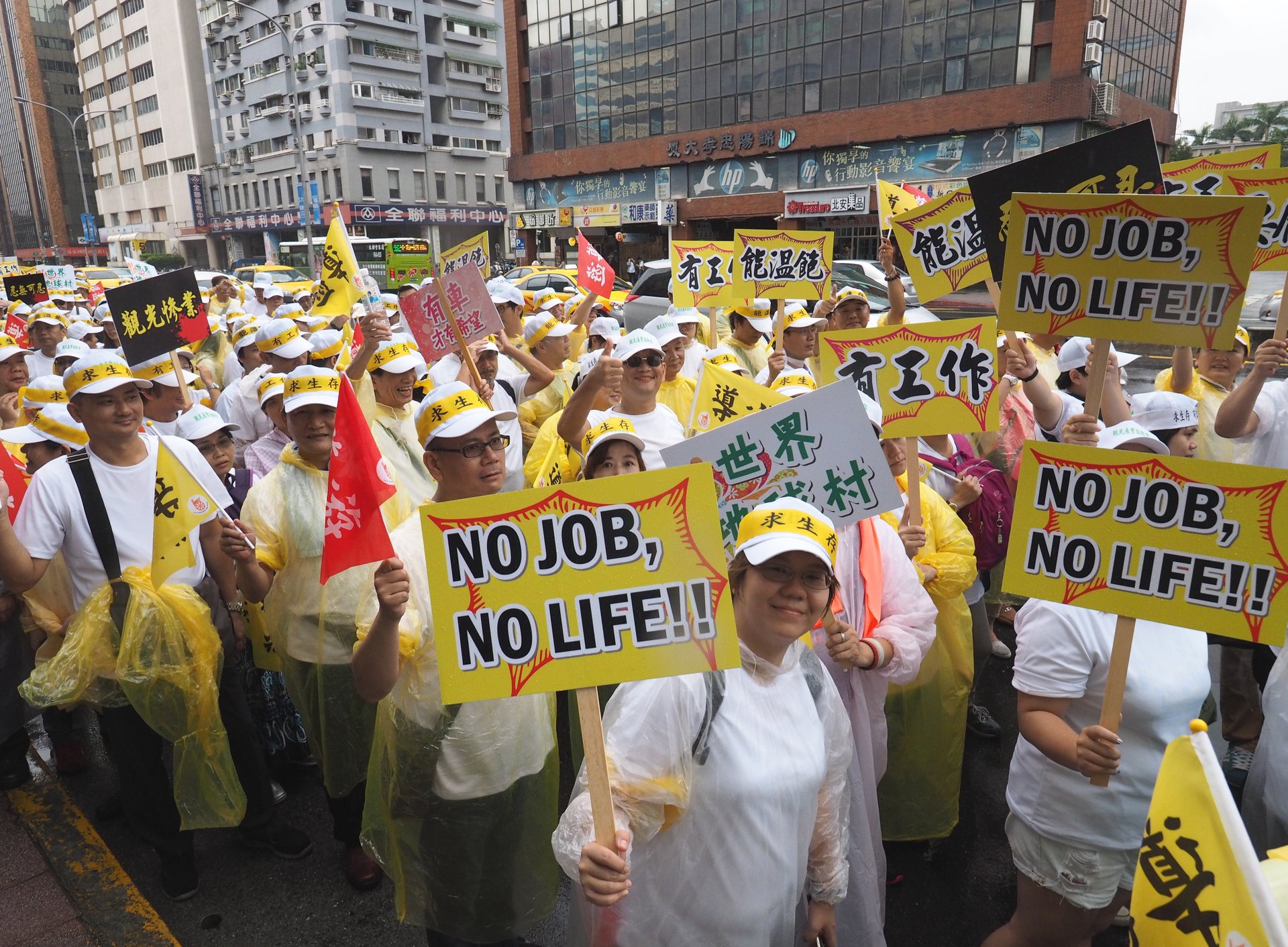China’s attempt to punish Taiwan by throttling tourism has seriously backfired
中文譯本:中國靠扼制旅游懲戒台灣,結果適得其反


中文譯本:中國靠扼制旅游懲戒台灣,結果適得其反
Taipei, Taiwan
During this year’s Lunar new year celebrations, Taipei’s famous Shilin night market was packed with Taiwanese, Japanese, Koreans, and Southeast Asians ambling from stall to stall, munching on cheap snacks. Conspicuous in their absence, however, were the Chinese group tourists that in previous years had arrived by the busload.
In the months following last May’s inauguration of president Tsai Ing-wen—whose party is seen to be sympathetic to Taiwanese independence and deeply disliked by Beijing—international and local pro-China media have focused on the negative economic impacts of China decreasing the flow of tour groups to Taiwan. After all, China is the biggest source of international visitors to Taiwan, which functions as a self-governing country but is claimed by Beijing as sovereign territory.
This narrative overlooks one major detail: Taiwan set a new record for international tourism last year. And it did so by courting visitors from the rest of Asia, thus reducing its reliance on Chinese tourists.
Last year Chinese group tours to Taiwan were down approximately 30%, and overall Chinese arrivals fell 16% year on year, according to Eric Lin, director of the Taiwan Tourism Bureau’s international department, yet it hosted nearly 10.7 million visitors in 2016, up from 10.4 million in 2015.
On Feb. 9, president Tsai tweeted about the record number of visitors with expressions of thanks in Chinese, Japanese, Korean, Thai, Malay, Tagalog, Vietnamese, and Hindi.
The choice of languages highlights the new priorities of Taiwan’s tourism officials: Southeast Asia, East Asia, and India. Under Tsai, Chinese group tours are no longer a top priority, and that probably makes sense for a couple of reasons.
Since early last year Beijing has been leaning on Chinese tour operators to reduce the flow of visitors to Taiwan. It wants to pressure Tsai—whose Democratic Progressive Party has espoused pro-independence sentiments—into at least paying lip service to the idea that there is only one China, even if Beijing and Taipei have differing interpretations of what that means. Tsai has said she wishes to preserve the cross-strait status quo, but Beijing is concerned that she will take Taiwan closer to formal independence. As a result she’s on far less friendly terms with Beijing than her predecessor, Ma Ying-jeou of the Kuomintang party.
In the two months after Tsai’s inauguration, Chinese group tours to Taiwan dropped by 30%. With no indication that Tsai intends to acknowledge the “One China” principle, for Taiwan, trying to woo back Chinese tour groups would likely prove fruitless.
“The entire dragon”
In any case, even when China was sending over large numbers of tour groups, they were only benefiting a small number of Taiwanese businesses that were aimed primarily at this market. On top of that, many of these local businesses were only getting a fraction of the total money spent, with most of the spoils going to Chinese tour organizers.
Many Taiwanese bus companies, hotels, restaurants, and shops frequented by these tour groups are also invested in by mainland Chinese, creating a closed economic ecosystem referred to as “the entire dragon.” On a per capita basis, these locally unpopular “zero-dollar” travelers were not contributing much to the local economy, and in some cases were crowding out domestic travelers, a phenomenon that has led to backlash elsewhere, including in Thailand.
Pauline Leung, co-chair of the Travel and Tourism Committee of the American Chamber of Commerce in Taipei, said that the fallout in Taiwan from reduced Chinese tourists was limited.
“Mainland tourists are only affecting certain businesses,” she noted. “There are only certain places they go.”
Of course, those relying on Chinese package tours for their livelihoods have been unhappy at the icy relations between Taipei and Beijing. Thousands from those affected businesses protested in a march through Taipei last September, demanding the Tsai government take a more China-friendly path.

The decline in tour groups from China is, however, being offset by higher-spending individual travelers from other countries—including China itself. Taiwan limits the number of Chinese visiting in tour groups to 5,000 per day, with individual Chinese tourists limited to the same number.
Chinese tourists are of course still welcome in Taiwan, and they still account for roughly one-third of inbound travelers. But Taipei is diversifying away from the China-centric approach that began under former president Ma, who opened the floodgates to tourism from China in 2008. Taiwan had virtually no Chinese tourists in 2007, according to the tourism bureau, compared to a peak of 4.2 million in 2015.
A successful counter-move
Visitor numbers from every other market except China grew last year, Lin said, with visitor figures from some markets growing by more than 50%. Thailand was up by 57% from the previous year.
Taiwan had until recently made it difficult for people from Southeast Asian countries to visit as tourists. That is changing.
Last August, citizens of Thailand and Brunei became eligible to visit Taiwan for 30 days without a visa, joining the more established markets of Singapore and Malaysia. Taiwan has also simplified the visa application process for other Southeast Asian markets, allowing them to apply online if they’ve previously obtained visas from any of a number of designated countries including the US, Canada, and Japan in the past decade. Lin said many of the Southeast Asian markets grew faster than his department had projected.
Asked if the developments in Taiwan’s tourism sector in 2016 caught his department by surprise, Lin said with a laugh: “I’d say things worked out quite well!”